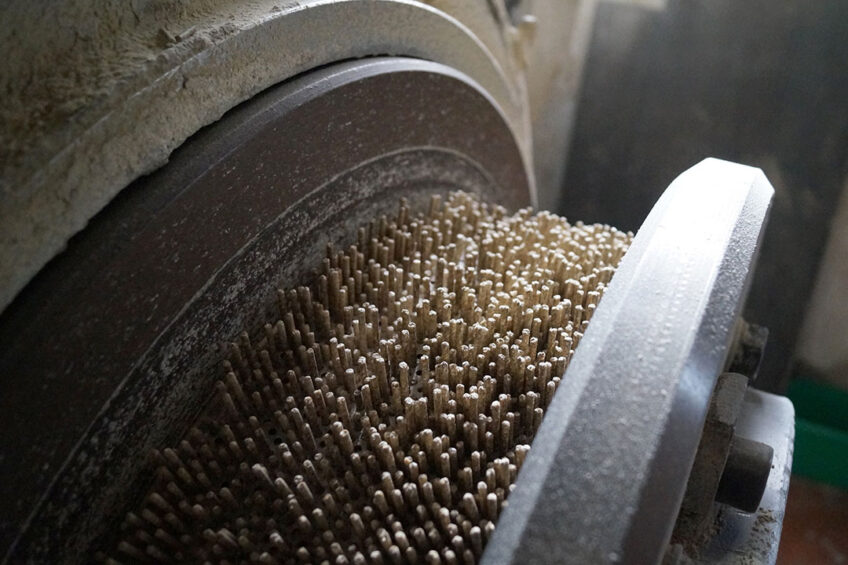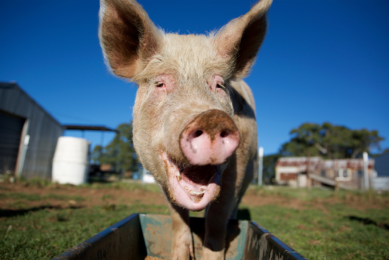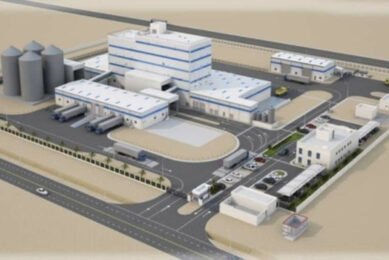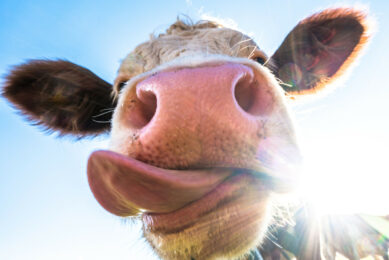Improving the pelleting process in the feed plant

One of the most important stages of feed production is the pelleting process. This article discusses pellet quality, the pelleting machine and how to optimise operation parameters to improve productivity.
Pelleting process
Pelleting transforms soft dusty feed into a hard pellet through compression, extrusion and adhesion. The pelleting process consists of 3 phases:
- Steam conditioning: is an important stage in the pelleting process which allows increased production rates and improved pellet durability during handling and transportation of finished feeds.
Furthermore, the addition of heat in steam conditioning improves binding and removes any pathogens in the feed. The pelleting phase is a combined mechanical process with moisture, pressure and heat aggregation of small-sized particles into larger-sized particles. - Pelleting: is performed by passing hot mash feed from the bin into the conditioner and feeder. The fine partials separated from the pellets can be collected in the sieve and returned into the pellet chamber for reprocessing. Pellets leave the chamber with a temperature of 80-90° Celsius, and moisture content between 150 and 170 g/kg.
- Cooling: During the cooling phase, the temperature needs to be reduced to eight degrees more than the ambient temperature and the moisture content should be adjusted between 100 and 120 g/kg.
Evaluating pellet quality
The quality of the pellet is evaluated based on its ability to withstand abrasion and fragmentation during pneumatic and mechanical movement. The pellet durability test, which determines the number of solid pellets withstanding the attrition stresses due to mechanical processes, is an estimate of the quality of pellets.
However, a variety of factors impact pellet quality including:
- protein content,
- density,
- particle size,
- fat content,
- fibre content,
- texture,
- moisture content and the gap between roller die in the pelleting machine
Prodcution rate vs pellet quality:
- High natural protein content with high density plasticises under heat improves the quality of pellets.
- Particle size reduction results in a better-quality pellet and a higher production rate because the steam penetrates the smaller particles through to the core, making them soft and pliable.
- High fat content increases production rate but reduces pellet quality.
- High fibre content reduces production rate but improves the quality of pellet due to natural binders inherent to fibre.
- Fine ground materials provide greater surface area for absorption of moisture from steam, resulting in better lubrication, increased production rate and improved pellet quality.
- Sufficient inbound moisture added prior to pelleting improves pellet durability.
- The gap between the roller and die affects the hardness and durability of the pellets. The roller-die gap of a pellet mill is the space between the annular matrix and the rollers. Generally, the narrower the gap is, the higher the pellets hardness and durability will be.
Function of the roller and die in pelleting machine
The roller and die are the core and most wearable parts of the pellet machine which determine the forming rate and pellet quality. The pellet die is mainly used to pelletise the ground material into cylindrical granules. Rollers rotate and force the raw material under intense pressure to produce pellets.
2 main categories of pellet machines are used in feed manufacturing:
- The flat die pellet machine – suitable for small scale feed manufacturing
- The ring die pellet machine – used for large-scale production due to its large production capacity and low power consumption
The major difference between ring die and flat die pellet machine are the shape of the dies and the position of rollers.
3 types of die patterns are used:
- Standard pattern – suitable for general feed applications with normal hole count, where many formulas are pelleted on the same die and machine
- Heavy-duty pattern – has less than a normal number of die holes, making the die stronger, and increasing the ligament thickness between the die.
- Closed hole pattern – has 25% more die holes than the standard pattern. Using a closed hole pattern increases pellet quality and production capacity, improves die wear, makes energy use more efficient, and reduces the average cost per tonne.
Roller shells design
The correct design of roller shells maximises the performance of the pelleting machine.
- Open-end corrugated shells are used for manufacturing high-fibre materials.
- Closed-end corrugated shells are generally used with poultry feed manufacturing for a well-conditioned, high-grain ration.
- Helical closed-end corrugated shells have a smoother operation than straight corrugated shells.
- Dimpled shells have good wear characteristics because of their increased surface area.
- Tungsten carbide shells are used for extremely abrasive applications such as pellet materials that either contain ground materials such as sand and dirt or those with a high mineral content.
Optimising the operating parameters
Defining pelleting machine operating parameters such as temperature, pressure and hole size and their impact on the overall quantity and quality of the pellet is very important. Jamming of the pelleting machine is the most frequent stoppage in the production line where the die can no longer pass the mash feed, and no pellets are being produced. One of the possible solutions to the jamming problem is a change in the hole size of the dies. Studies showed that a hole size of 4 mm improves the pellet durability index and average productivity, while decreasing the stoppage time in pelleting machine due to jamming. For the conditioning process to be optimised, a balance between moisture and heat is required. Using steam and higher temperature the starch content of feed is partly gelatinised and this makes the pellets tighter and denser. As a result, the friction reduces, thus increasing the efficiency and lengthening the life of the die and the rollers. The best operation parameters are at a temperature of 81°C and pressure of 2.074 Bar which increase the pellet durability index from 87.37% to 88.6%.
Concluding remarks
One of the most important stages of feed production is the pelleting process which transforms soft dusty feed into a hard pellet through compression, extrusion and adhesion.
The pelleting process, which consists of 3 phases – steam conditioning, pelleting and cooling – is affected by protein content, density, particle size, fat content, fibre content, texture, moisture content and the gap between the roller and die in the pelleting machine. To optimise the productivity of pelleting machines the operating parameters such as temperature, pressure, and hole size need to be improved within the feed mill by experimentation.
This article is based on the publication: Amin SAS, Sobhi N. Process optimization in the poultry feed mill. Sci Rep. 2023 Jun 19;13(1):9897.
The All About Feed Newsletter
Sign up for our newsletter and receive all our need-to-know content three times a week.











